Horror fiction
Horror is a genre of speculative fiction which is intended to frighten, scare, disgust, or startle its readers by inducing feelings of horror and terror. Literary historian J. A. Cuddon defined the horror story as "a piece of fiction in prose of variable length... which shocks, or even frightens the reader, or perhaps induces a feeling of repulsion or loathing".[1] It creates an eerie and frightening atmosphere. Horror is frequently supernatural, though it might also be non-supernatural. Often the central menace of a work of horror fiction can be interpreted as a metaphor for the larger fears of a society.

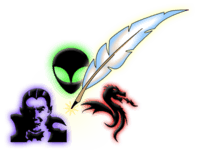 |
| Speculative fiction |
|---|
|
|
|
|
History
Horror in ancient Greece and Rome
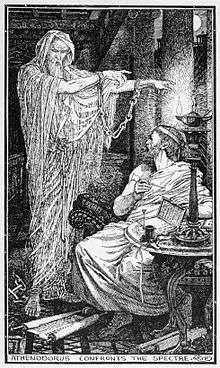
The horror genre has ancient origins with roots in folklore and religious traditions, focusing on death, the afterlife, evil, the demonic and the principle of the thing embodied in the person.[2] These were manifested in stories of beings such as demons, witches, vampires, werewolves and ghosts. European horror fiction became established through works of the Ancient Greeks and Ancient Romans. The well-known 19th-century novel about Frankenstein was greatly influenced by the story of Hippolytus, where Asclepius revives him from death.[3] Euripides wrote plays based on the story, Hippolytos Kalyptomenos and Hippolytus.[4] In Plutarch's The Lives of the Noble Grecians and Romans focused on Cimon, the author describes the spirit of a murderer, Damon, who himself was murdered in a bathhouse in Chaeronea.[5]
Pliny the Younger tells the tale of Athenodorus Cananites who bought a haunted house in Athens. Athenodorus was cautious since the house was inexpensive. While writing a book on philosophy, he was visited by a ghostly appearing figure bound in chains. The figure disappeared in the courtyard; the following day, the magistrates dug it up to find an unmarked grave.[6]
Horror after AD 1000
Werewolf stories were popular in medieval French literature. One of Marie de France's twelve lais is a werewolf story titled "Bisclavret".
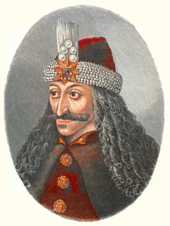
The Countess Yolande commissioned a werewolf story titled "Guillaume de Palerme". Anonymous writers penned two werewolf stories, "Biclarel" and "Melion".
Much horror fiction derives from the cruellest personages of the 15th century. Dracula can be traced to the Prince of Wallachia Vlad III, whose alleged war crimes were published in German pamphlets. A 1499 pamphlet was published by Markus Ayrer, which is most notable for its woodcut imagery.[7] The alleged serial-killer sprees of Gilles de Rais have been seen as the inspiration for "Bluebeard".[8] The motif of the vampiress is most notably derived from the real-life noblewoman and murderess, Elizabeth Bathory, and helped usher in the emergence of horror fiction in the 18th century, such as through László Turóczi's 1729 book Tragica Historia.[9]
Gothic horror in the 18th century
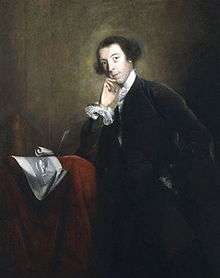
The 18th century saw the gradual development of Romanticism and the Gothic horror genre. It drew on the written and material heritage of the Late Middle Ages, finding its form with Horace Walpole's seminal and controversial 1764 novel, The Castle of Otranto. In fact, the first edition was published disguised as an actual medieval romance from Italy, discovered and republished by a fictitious translator.[10] Once revealed as modern, many found it anachronistic, reactionary, or simply in poor taste but it proved immediately popular.[10] Otranto inspired Vathek (1786) by William Beckford, A Sicilian Romance (1790), The Mysteries of Udolpho (1794) and The Italian (1796) by Ann Radcliffe and The Monk (1797) by Matthew Lewis.[10] A significant amount of horror fiction of this era was written by women and marketed towards a female audience, a typical scenario of the novels being a resourceful female menaced in a gloomy castle.[11]
Horror in the 19th century
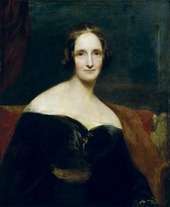
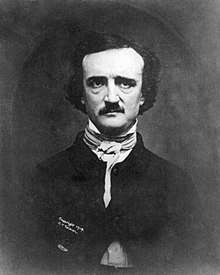
The Gothic tradition blossomed into the genre that modern readers today call horror literature in the 19th century. Influential works and characters that continue resonating in fiction and film today saw their genesis in the Brothers Grimm's "Hänsel und Gretel" (1812), Mary Shelley's Frankenstein (1818), John Polodori's "The Vampyre" (1819), Charles Maturin's Melmoth the Wanderer (1820), Washington Irving's "The Legend of Sleepy Hollow" (1820), Jane C. Loudon's The Mummy!: Or a Tale of the Twenty-Second Century (1827), Victor Hugo's The Hunchback of Notre Dame (1831), Thomas Peckett Prest's Varney the Vampire (1847), the works of Edgar Allan Poe, the works of Sheridan Le Fanu, Robert Louis Stevenson's Strange Case of Dr Jekyll and Mr Hyde (1886), Oscar Wilde's The Picture of Dorian Gray (1890), H. G. Wells' The Invisible Man (1897), and Bram Stoker's Dracula (1897). Each of these works created an enduring icon of horror seen in later re-imaginings on the page, stage and screen.[12]
Horror in the 20th century
A proliferation of cheap periodicals around turn of the century led to a boom in horror writing. For example, Gaston Leroux serialized his Le Fantôme de l'Opéra before it became a novel in 1910. One writer who specialized in horror fiction for mainstream pulps, such as All-Story Magazine, was Tod Robbins, whose fiction deals with themes of madness and cruelty.[13][14] Later, specialist publications emerged to give horror writers an outlet, prominent among them was Weird Tales[15] and Unknown Worlds.[16]
Influential horror writers of the early 20th century made inroads in these mediums. Particularly, the venerated horror author H.P. Lovecraft, and his enduring Cthulhu Mythos transformed and popularized the genre of cosmic horror, and M.R. James is credited with redefining the ghost story in that era.[17]
The serial murderer became a recurring theme. Yellow journalism and sensationalism of various murderers, such as Jack the Ripper, and lesser so, Carl Panzram, Fritz Haarman, and Albert Fish, all perpetuated this phenomenon. The trend continued in the postwar era, partly renewed after the murders committed by Ed Gein. In 1959, Robert Bloch, inspired by the murders, wrote Psycho. The crimes committed in 1969 by the Manson family influenced the slasher theme in horror fiction of the 1970s. In 1981, Thomas Harris wrote Red Dragon, introducing Dr. Hannibal Lecter. In 1988, the sequel to that novel, The Silence of the Lambs, was published.
Early cinema was inspired by many aspects of horror literature, and started a strong tradition of horror films and subgenres that continues to this day. Up until the graphic depictions of violence and gore on the screen commonly associated with 1960s and 1970s slasher films and splatter films, comic books such as those published by EC Comics (most notably Tales From The Crypt) in the 1950s satisfied readers' quests for horror imagery that the silver screen could not provide.[18] This imagery made these comics controversial, and as a consequence, they were frequently censored.[19][20]
The modern zombie tale dealing with the motif of the living dead harks back to works including H.P. Lovecraft's stories "Cool Air" (1925), "In The Vault" (1926), and "The Outsider" (1926), and Dennis Wheatley's "Strange Conflict" (1941). Richard Matheson's novel I Am Legend (1954) influenced an entire genre of apocalyptic zombie fiction emblematized by the films of George A. Romero.
In the late 1960s and early 1970s, the enormous commercial success of three books - Rosemary's Baby (1967) by Ira Levin, The Exorcist by William Peter Blatty, and The Other by Thomas Tryon - encouraged publishers to begin releasing numerous other horror novels, thus creating a "horror boom".[21][22]
One of the best-known late-20th century horror writers is Stephen King, known for Carrie, The Shining, It, Misery and several dozen other novels and about 200 short stories.[23][24][25] Beginning in the 1970s, King's stories have attracted a large audience, for which he was awarded by the U.S. National Book Foundation in 2003.[26] Other popular horror authors of the period included Anne Rice, Brian Lumley, Graham Masterton, James Herbert, Dean Koontz, Clive Barker,[27] Ramsey Campbell,[28] and Peter Straub.
Post-millennial horror fiction
Best-selling book series of contemporary times exist in genres related to horror fiction, such as the werewolf fiction urban fantasy Kitty Norville books by Carrie Vaughn (2005 onward). Horror elements continue to expand outside the genre. The alternate history of more traditional historical horror in Dan Simmons's 2007 novel The Terror sits on bookstore shelves next to genre mash ups such as Pride and Prejudice and Zombies (2009), and historical fantasy and horror comics such as Hellblazer (1993 onward) and Mike Mignola's Hellboy (1993 onward). Horror also serves as one of the central genres in more complex modern works such as Mark Z. Danielewski's House of Leaves (2000), a finalist for the National Book Award. There are many horror novels for teens, such as The Monstrumologist by Rick Yancey (2009). Additionally, many movies, particularly animated ones, use a horror aesthetic. These are what can be collectively referred to as "children's horror".[29] Although it's unknown for sure why children enjoy these movies (as it seems counter-intuitive), it is theorized that it is the grotesque monsters that fascinate kids.[29] Tangential to this, the internalized impact of horror television programs and films on children is rather under-researched, especially when compared to the research done on the similar subject of violence in TV and film's impact on the young mind. What little research there is tends to be inconclusive on the impact that viewing such media has.[30]
Characteristics
One defining trait of the horror genre is that it provokes an emotional, psychological, or physical response within readers that causes them to react with fear. One of H.P. Lovecraft's most famous quotes about the genre is that: "The oldest and strongest emotion of mankind is fear, and the oldest and strongest kind of fear is fear of the unknown."[31] the first sentence from his seminal essay, "Supernatural Horror in Literature". Science fiction historian Darrell Schweitzer has stated "In the simplest sense, a horror story is one that scares us" and "the true horror story requires a sense of evil, not in necessarily in a theological sense; but the menaces must be truly menacing, life-destroying, and antithetical to happiness."[32]
In her essay "Elements of Aversion", Elizabeth Barrette articulates the need by some for horror tales in a modern world:
The old "fight or flight" reaction of our evolutionary heritage once played a major role in the life of every human. Our ancestors lived and died by it. Then someone invented the fascinating game of civilization, and things began to calm down. Development pushed wilderness back from settled lands. War, crime, and other forms of social violence came with civilization and humans started preying on each other, but by and large daily life calmed down. We began to feel restless, to feel something missing: the excitement of living on the edge, the tension between hunter and hunted. So we told each other stories through the long, dark nights. when the fires burned low, we did our best to scare the daylights out of each other. The rush of adrenaline feels good. Our hearts pound, our breath quickens, and we can imagine ourselves on the edge. Yet we also appreciate the insightful aspects of horror. Sometimes a story intends to shock and disgust, but the best horror intends to rattle our cages and shake us out of our complacency. It makes us think, forces us to confront ideas we might rather ignore, and challenges preconceptions of all kinds. Horror reminds us that the world is not always as safe as it seems, which exercises our mental muscles and reminds us to keep a little healthy caution close at hand.[33]
In a sense similar to the reason a person seeks out the controlled thrill of a roller coaster, readers in the modern era seek out feelings of horror and terror to feel a sense of excitement. However, Barrette adds that horror fiction is one of the few mediums where readers seek out a form of art that forces themselves to confront ideas and images they "might rather ignore to challenge preconceptions of all kinds."
One can see the confrontation of ideas that readers and characters would "rather ignore" throughout literature in famous moments such as Hamlet's musings about the skull of Yorick, its implications of the mortality of humanity, and the gruesome end that bodies inevitably come to. In horror fiction, the confrontation with the gruesome is often a metaphor for the problems facing the current generation of the author.
There are many theories as to why people enjoy being scared. For example, "people who like horror films are more likely to score highly for openness to experience, a personality trait linked to intellect and imagination."[34]
Stephanie Demetrakopoulos illustrates a common interpretation of one of the benchmarks of the canon of horror literature.[35] Tina Broussard in an Horror Stories - Ghost Stories of Dracula surmises Demetrakopoulos' thesis:
This scholarly journal article explores sexuality in Dracula, including overtones of sexuality in the typical aggressive male and female sexuality which is either reflective of the chaste woman or the sexually aggressive female vampire. Demetrakopoulos suggests Dracula was an outlet for Victorian society, breaking through sexual norms with symbolic group orgies, male desire for sexually aggressive women, denial of motherhood, etc. She highlights ways in which the females defy gender boundaries by embodying masculine traits such as intelligence.[36]
It is a now commonly accepted viewpoint that the horror elements of Dracula's portrayal of vampirism are metaphors for sexuality in a repressed Victorian era.[35] But this is merely one of many interpretations of the metaphor of Dracula. Judith Halberstam postulates many of these in her essay Technologies of Monstrosity: Bram Stoker's Dracula. She writes:
[The] image of dusty and unused gold, coins from many nations and old unworn jewels, immediately connects Dracula to the old money of a corrupt class, to a kind of piracy of nations and to the worst excesses of the aristocracy.[37]
_Irish_Frankenstein.jpg)
Menacing villains and monsters in horror literature can often be seen as metaphors for the fears incarnate of a society.
Halberstram articulates a view of Dracula as manifesting the growing perception of the aristocracy as an evil and outdated notion to be defeated. The depiction of a multinational band of protagonists using the latest technologies (such as a telegraph) to quickly share, collate, and act upon new information is what leads to the destruction of the vampire. This is one of many interpretations of the metaphor of only one central figure of the canon of horror fiction, as over a dozen possible metaphors are referenced in the analysis, from the religious to the anti-semitic.[38]
Noël Carroll's Philosophy of Horror postulates that a modern piece of horror fiction's "monster", villain, or a more inclusive menace must exhibit the following two traits:
- A menace that is threatening — either physically, psychologically, socially, morally, spiritually, or some combination of the aforementioned.
- A menace that is impure — that violates the generally accepted schemes of cultural categorization. "We consider impure that which is categorically contradictory".[39]
Scholarship and criticism
In addition to those essays and articles shown above, scholarship on horror fiction is almost as old as horror fiction itself. In 1826, the gothic novelist Ann Radcliffe published an essay distinguishing two elements of horror fiction, "terror" and "horror." Whereas terror is a feeling of dread that takes place before an event happens, horror is a feeling of revulsion or disgust after an event has happened.[40] Radcliffe describes terror as that which "expands the soul and awakens the faculties to a high degree of life," whereas horror is described as that which "freezes and nearly annihilates them."
Modern scholarship on horror fiction draws upon a range of sources. In their historical studies of the gothic novel, both Devandra Varma[41] and S.L. Varnado[42] make reference to the theologian Rudolf Otto, whose concept of the "numinous" was originally used to describe religious experience.
A recent survey reports how often horror media is consumed:
To assess frequency of horror consumption, we asked respondents the following question: “In the past year, about how often have you used horror media (e.g., horror literature, film, and video games) for entertainment?” 11.3% said “Never,” 7.5% “Once,” 28.9% “Several times,” 14.1% “Once a month,” 20.8% “Several times a month,” 7.3% “Once a week,” and 10.2% “Several times a week.” Evidently, then, most respondents (81.3%) claimed to use horror media several times a year or more often. Unsurprisingly, there is a strong correlation between liking and frequency of use (r=.79, p<.0001).[43]
Awards and associations
Achievements in horror fiction are recognized by numerous awards. The Horror Writer's Association presents the Bram Stoker Awards for Superior Achievement, named in honor of Bram Stoker, author of the seminal horror novel Dracula.[44] The Australian Horror Writers Association presents annual Australian Shadows Awards. The International Horror Guild Award was presented annually to works of horror and dark fantasy from 1995 to 2008.[45][46] The Shirley Jackson Awards are literary awards for outstanding achievement in the literature of psychological suspense, horror, and the dark fantastic works. Other important awards for horror literature are included as subcategories within general awards for fantasy and science fiction in such awards as the Aurealis Award.
Alternate terms
Some writers of fiction normally classified as "horror" tend to dislike the term, considering it too lurid. They instead use the terms dark fantasy or Gothic fantasy for supernatural horror,[47] or "psychological thriller" for non-supernatural horror.[48]
See also
- Related genres
- Horror convention
- Horror podcast
- LGBT themes in horror fiction
- List of horror films
- List of horror fiction writers
- List of ghost films
- List of horror television programs
References
- Cuddon, J.A. (1984). "Introduction". The Penguin Book of Horror Stories. Harmondsworth: Penguin. p. 11. ISBN 0-14-006799-X.
- Jackson, Rosemary (1981). Fantasy: The Literature of Subversion. London: Methuen. pp. 53–5, 68–9.
- Though the sub-title of Frankenstein references the titan Prometheus, none of the ancient myths about him is itself a horror tale.
-
- Edward P. Coleridge, 1891, prose: full text Archived 12 April 2006 at the Wayback Machine
-
- John Dryden, 1683: full text
- Pliny the Younger (1909–14). "LXXXIII. To Sura". In Charles W. Eliot. Letters, by Pliny the Younger; translated by William Melmoth; revised by F. C. T. Bosanquet. The Harvard Classics. 9. New York: P.F. Collier & Son.
- Raymond T. McNally and Radu R. Florescu (1972). "In Search of Dracula." Houghton Milton. Pages 8–9.
- Kiernan, Dr. Jas. G. "Sexual Perversion, and the Whitechapel Murders." The Medical Standard: IV.5. G. P. Engelhard and Company: Chicago.
- in Ungaria suis cum regibus compendia data, Typis Academicis Soc. Jesu per Fridericum Gall. Anno MCCCXXIX. Mense Sepembri Die 8. p 188-193, quoted by Farin
- "The Castle of Otranto: The creepy tale that launched gothic fiction". BBC. Retrieved 15 July 2017
- Richard Davenport-Hines (1998). Gothic: 1500 Years of Excess, Horror, Evil and Ruin. London: Fourth Estate.
- Christopher Frayling (1996). Nightmare: The Birth of Horror. London: BBC Books.
- Brian Stableford, "Robbins, Tod", in David Pringle, ed., St. James Guide to Horror, Ghost & Gothic Writers (London: St. James Press, 1998) ISBN 1558622063 (pp. 480–1).
- Lee Server. Encyclopedia of Pulp Fiction Writers. New York: Facts On File, 2002. ISBN 978-0-8160-4578-5 (pp. 223–224).
- Robert Weinberg, "Weird Tales" in M.B Tymn and Mike Ashley, Science Fiction, Fantasy, and Weird Fiction Magazines. Westport, CT: Greenwood, 1985.ISBN 0-313-21221-X (pp. 727–736).
- "Unknown". in: M.B. Tymn and Mike Ashley, Science Fiction, Fantasy, and Weird Fiction Magazines. Westport: Greenwood, 1985. pp.694-698. ISBN 0-313-21221-X
- "Medieval Studies and the Ghost Stories of M. R. James By Patrick J. Murphy". www.psupress.org. Retrieved 17 March 2020.
- Hutchings, Peter (2008). The A to Z of Horror Cinema. The A to Z Guide Series. 100. Lanham, MD: The Scarecrow Press, Inc. p. 72. ISBN 978-0-8108-6887-8. Retrieved 29 October 2015.
- Collins, Max Allan (28 February 2013). "11 Most Controversial Comic Books". HuffPost. Retrieved 5 February 2019.
- Hansen, Kelli (1 October 2012). "Banned Books Week: Comics and Controversy". University of Missouri. Retrieved 5 February 2019.
- "Ira Levin's Rosemary's Baby (1967), Thomas Tyron's The Other (1971), and William Peter Blatty's The Exorcist (1971) were all released within a few years of one another...and their immense combined sales indicted to many publishers that horror was now a profitable marketing niche." Simmons, David, American Horror Fiction and Class: From Poe to Twilight. London: Palgrave Macmillan 2017 ISBN 9781137532800 (p.119)
- Pringle,David, "Rosemary's Baby", in Pringle (ed.) Modern Fantasy: The 100 Best Novels. London, Grafton, 1988. ISBN 0246132140 (p.103-5)
- Barone, Matt (8 November 2011). "The 25 Best Stephen King Stories". Complex. Retrieved 5 February 2019.
- Jackson, Dan (18 February 2016). "A Beginner's Guide to Stephen King Books". Thrillist. Retrieved 5 February 2019.
- Richard Bleiler, "Stephen King" in: Bleiler, Ed. Supernatural Fiction Writers: Contemporary Fantasy and Horror. New York: Thomson/Gale, 2003, ISBN 9780684312507. (pp. 525-540).
- Hillel Italie (18 September 2003). "Stephen King receives honorary National Book Award". Ellensburg Daily Record. Retrieved 12 September 2010.
Stephen King, brand-name writer, master of the horror story and e-book pioneer, has received an unexpected literary honor: a National Book Award for lifetime achievement.
- K.A. Laity "Clive Barker" in Richard Bleiler, ed. Supernatural Fiction Writers: Contemporary Fantasy and Horror. New York: Thomson/Gale, 2003. ISBN 9780684312507 (pp. 61–70).
- K.A. Laity, "Ramsey Campbell", in Richard Bleiler, ed. Supernatural Fiction Writers: Contemporary Fantasy and Horror. New York: Thomson/Gale, 2003. ISBN 9780684312507 (pp. 177–188.)
- Lester, Catherine (Fall 2016). "The Children's Horror Film". The Velvet Light Trap. 78 (78): 22–37. doi:10.7560/VLT7803.
- Pearce, Laura J.; Field, Andy P. (2016). "The Impact of "Scary" TV and Film on Children's Internalizing Emotions: A Meta-Analysis". Human Communication Research. 42 (1): 98–121. doi:10.1111/hcre.12069. ISSN 1468-2958.
- "Golden Proverbs". Retrieved 15 December 2012.
- Schweitzer, Darrell, "Why Horror Fiction?" in Windows of the Imagination. Berkeley Heights, NJ : Wildside Press, 1999. ISBN 9781880448601 (p. 64, 67).
- "Elements of Aversion". Archived from the original on 28 February 2013. Retrieved 2 November 2012.
- Whyte, Chelsea (9 February 2019). "The benefits of being scared". New Scientist. 241 (3216): 8. doi:10.1016/S0262-4079(19)30224-6.
- Stephanie Demetrakopoulos (Autumn 1977). "Feminism, Sex Role Exchanges, and Other Subliminal Fantasies in Bram Stoker's "Dracula"". Frontiers: A Journal of Women Studies. University of Nebraska Press. 2 (3): 104–113. doi:10.2307/3346355. JSTOR 3346355.
- "Horror Stories - ghost Stories".
- "Technologies of Monstrosity" (PDF). Archived from the original (PDF) on 12 May 2013. Retrieved 2 November 2012.
- "Lecture Notes for Dracula". Archived from the original on 25 October 2012. Retrieved 2 November 2012.
- "Horror Stories". Dating Ghosts.
- Mrs Radcliffe, "On the Supernatural in Poetry", The New Monthly Magazine 7 (1826): 145–52.
- Devandra Varma, The Gothic Flame (New York: Russell & Russell, 1966.
- S.L. Varnado, "The Idea of the Numinous in Gothic Literature," in The Gothic Imagination, ed. G.R. Thompson (Pullman: Washington State University Press, 1974).
- "Horror, Personality, and Threat Simulation: A Survey on the Psychology of Scary Media | Request PDF". ResearchGate. Retrieved 3 May 2019.
- "The Bram Stoker Awards". Horror Writer's Association. Archived from the original on 10 March 2007. Retrieved 13 April 2010.
- "IHG Award Recipients 1994–2006". HorrorAward.org. Archived from the original on 22 April 2009. Retrieved 30 October 2014.
- "IHG Award Recipients 2007". HorrorAward.org. Retrieved 30 October 2014.
- Brian Stableford, "Horror", in The A to Z of Fantasy Literature (p. 204), Scarecrow Press, Plymouth. 2005. ISBN 0-8108-6829-6.
- Brian Stableford, "Non-supernatural horror stories tend to be psychological thrillers, often involving criminals of an unusually lurid stripe." "The Discovery of Secondary Worlds:Some Notes on the Aesthetics and Methodology of Heterocosmic Creativity", in Heterocosms. Wildside Press LLC, 2007 ISBN 0809519070 (p. 200).
Further reading
- Neil Barron, Horror Literature: A Reader's Guide. New York: Garland, 1990. ISBN 978-0824043476.
- Jason Colavito, Knowing Fear: Science, Knowledge and the Development of the Horror Genre. Jefferson, NC: McFarland, 2008. ISBN 978-0786432738.
- Brian Docherty, American Horror Fiction: From Brockden Brown to Stephen King. New York: St. Martin's, 1990. ISBN 978-0333461297.
- Errickson, Will; Hendrix, Grady (2017). Paperbacks from Hell: The Twisted History of '70s and '80s Horror Fiction. Philadelphia: Quirk Books. ISBN 9781594749810. OCLC 1003294393.
- Stephen Jones and Kim Newman, (eds.), Horror: 100 Best Books. New York: Carroll & Graf, 1998. ISBN 0786705523.
- Stephen King, Danse Macabre. New York: Everest House, 1981. ISBN 978-0896960763.
- H.P. Lovecraft, Supernatural Horror in Literature, 1927, rev. 1934, collected in Dagon and Other Macabre Tales. Arkham House, 1965.
- David J. Skal, The Monster Show: A Cultural History of Horror. New York: Norton, 1993. ISBN 978-0859652117.
- Andrea Sauchelli "Horror and Mood", American Philosophical Quarterly, 51:1 (2014), pp. 39–50.
- Gina Wisker, Horror Fiction: An Introduction. New York: Continuum, 2005. ISBN 978-0826415615.
External links
| Library resources about Horror fiction |
| Wikisource has original text related to this article: |
| Wikivoyage has a travel guide for Horror fiction. |
| Wikimedia Commons has media related to Horror. |
